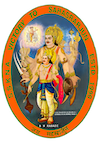When Parashuram cut Sahasrarjun’s hands he was again limbless as the way he was born. And as foretold—Sahasrarjun returned to God Vishnu at his abode in heaven.
Folklore at Maheshwar reports that Sahasrarjun after his dual with Parashuram, stood in the Narmada River near Kali temple and prayed to God Shiva, who blessed him and caused their souls to merge. God Shiva pronounced “henceforth you will be remembered as Shiva and your wife as Parvati.” Hence, the Kartaviryarjun temple on the banks of the Narmada River at Maheshwar is called Shivalaya and contains a Shiva Lingu. Recently devotees erected an portable idol representing Sahasrarjun and his wife. It is made of 7 metal elements. Few referred to it as Shiva Parvati idol. The pilgrims parade this idol around town during Sahasrarjuns birthday celebrations. At the Shivalaya entrance a large sign reads: “Raj Rajeshwar Kartaviryarjun.”
Parashuram’s maternal ancestry was Kshatirya, and his character traits came about as the result of his grandmother, Satyavati, drinking a fertility potion imbued with Kshatirya traits that would manifest in one of her grandchildren. However, he was born a Brahman and had to pay for his sin of ruthlessly killing 21 generations of Kshatriya. Accordingly, he was exiled from Sahasrarjun’s kingdom by his fellow Brahamans who felt that his sinful bloody actions against the Kshatriyas had left a stain on them.
Towards the end of Parashrurams life, he had no country—roaming all over India until he reached the south at Konkan. He threw his ax in the ocean causing it to recede and create new land, a present day Konkan. Parashuram was further humbled by Kshatriya king Ram, avatar of Vishnu, who broke his bow in a contest that had been gifted to him by Shiva.

















































